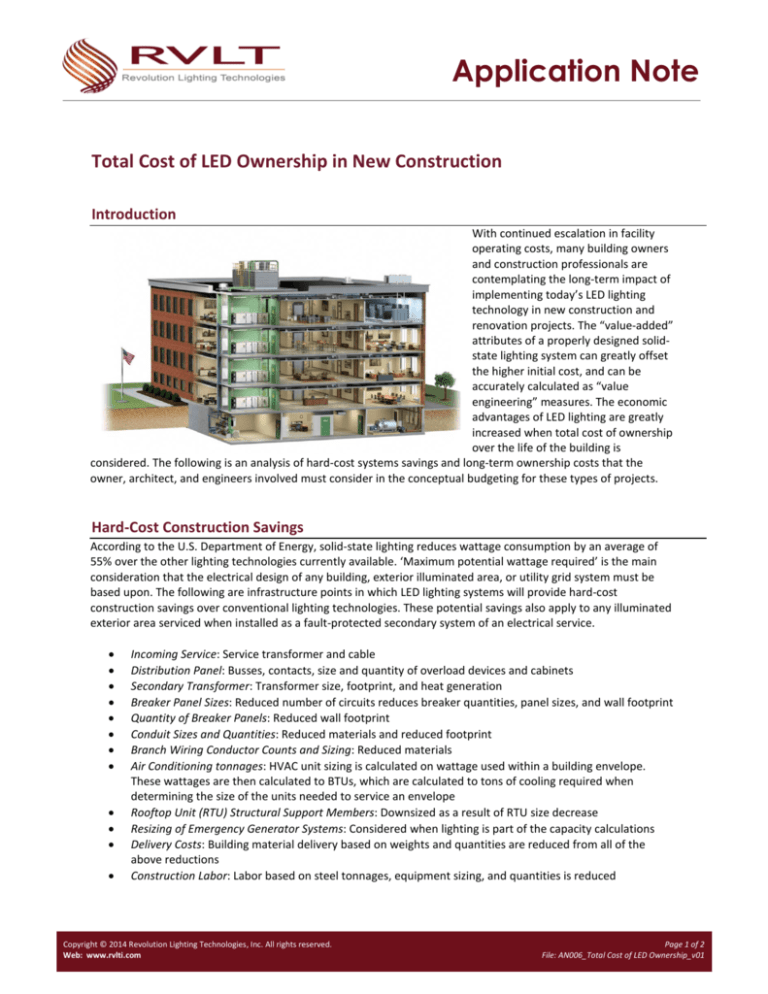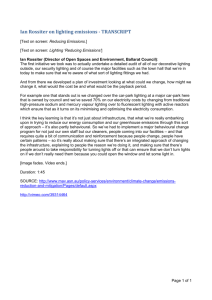
Application
Note
Product
Release
Total Cost of LED Ownership in New Construction
Introduction
With continued escalation in facility
operating costs, many building owners
and construction professionals are
contemplating the long-term impact of
implementing today’s LED lighting
technology in new construction and
renovation projects. The “value-added”
attributes of a properly designed solidstate lighting system can greatly offset
the higher initial cost, and can be
accurately calculated as “value
engineering” measures. The economic
advantages of LED lighting are greatly
increased when total cost of ownership
over the life of the building is
considered. The following is an analysis of hard-cost systems savings and long-term ownership costs that the
owner, architect, and engineers involved must consider in the conceptual budgeting for these types of projects.
Hard-Cost Construction Savings
According to the U.S. Department of Energy, solid-state lighting reduces wattage consumption by an average of
55% over the other lighting technologies currently available. ‘Maximum potential wattage required’ is the main
consideration that the electrical design of any building, exterior illuminated area, or utility grid system must be
based upon. The following are infrastructure points in which LED lighting systems will provide hard-cost
construction savings over conventional lighting technologies. These potential savings also apply to any illuminated
exterior area serviced when installed as a fault-protected secondary system of an electrical service.
•
•
•
•
•
•
•
•
•
•
•
•
Incoming Service: Service transformer and cable
Distribution Panel: Busses, contacts, size and quantity of overload devices and cabinets
Secondary Transformer: Transformer size, footprint, and heat generation
Breaker Panel Sizes: Reduced number of circuits reduces breaker quantities, panel sizes, and wall footprint
Quantity of Breaker Panels: Reduced wall footprint
Conduit Sizes and Quantities: Reduced materials and reduced footprint
Branch Wiring Conductor Counts and Sizing: Reduced materials
Air Conditioning tonnages: HVAC unit sizing is calculated on wattage used within a building envelope.
These wattages are then calculated to BTUs, which are calculated to tons of cooling required when
determining the size of the units needed to service an envelope
Rooftop Unit (RTU) Structural Support Members: Downsized as a result of RTU size decrease
Resizing of Emergency Generator Systems: Considered when lighting is part of the capacity calculations
Delivery Costs: Building material delivery based on weights and quantities are reduced from all of the
above reductions
Construction Labor: Labor based on steel tonnages, equipment sizing, and quantities is reduced
Copyright © 2014 Revolution Lighting Technologies, Inc. All rights reserved.
Web: www.rvlti.com
Page 1 of 2
File: AN006_Total Cost of LED Ownership_v01
Application Note
Operational Cost Savings
Beyond these construction cost factors, the total ownership of operating solid-state lighting systems is much lower
than any traditional technology when the following costs are considered:
•
•
•
•
•
•
•
•
•
•
Energy consumption: Minimum of 55% reduction over other technologies
Replacement lamps: Life ratings are 5-20x longer than conventional lighting
Replacement ballasts: Most LED fixtures and lamps have integral drivers that don’t require field servicing
Maintenance labor: Long life results in nearly zero maintenance labor costs for years
Maintenance equipment: Unplanned high-access equipment needs for lighting systems are virtually
eliminated
Maintenance risk: Near-zero maintenance work at heights, reduces or eliminates fall risk
Overhead costs of facility operations: Communication of maintenance needed, service requests, work
orders, maintenance contracting, insurance risks, material ordering and lighting material storage areas are
practically eliminated
Production loss: Downtime for lighting maintenance is virtually eliminated
Production loss: Downtime due to re-strike cycles in power spikes, outages and generator transfer events
are eliminated due to the “instant-on” attribute of solid-state lighting
Increased maintenance with control systems: Conventional lamp and ballast lives are greatly reduced with
increased on/off cycles when used with control systems. On/off cycles have no degrading affect on solidstate lighting systems
Conclusion
While the higher initial cost of LED lighting systems may give the impression that the technology is too expensive,
the reality is that LED lighting offers a true “value-engineered” solution for modern building practices. When
calculated from a global perspective, the savings in infrastructure construction costs and the resulting leaner
operating profile of the building prove that LED lighting is the right choice. Modern design-build and construction
professionals who embrace solid-state lighting set themselves apart as the most forward-thinking members of the
construction community. Projects that incorporate this technology yield tremendous long-term benefits to building
owners. When the “total cost of ownership” is calculated for any project, LED lighting proves out as true “valueengineering”.
About RVLT
Revolution Lighting Technologies, Inc. manufactures an extensive line of high-quality interior and exterior LED
lamps and fixtures that produce immediate energy savings and a rapid return on investment. We offer an
extensive lighting product line backed by warranties of up to 10 years to meet most commercial, industrial or
residential installation and retrofit needs.
For more information, please visit http://www.rvlti.com/.
Copyright © 2014 Revolution Lighting Technologies, Inc. All rights reserved.
Web: www.rvlti.com
Page 2 of 2
File: AN006_Total Cost of LED Ownership_v01







